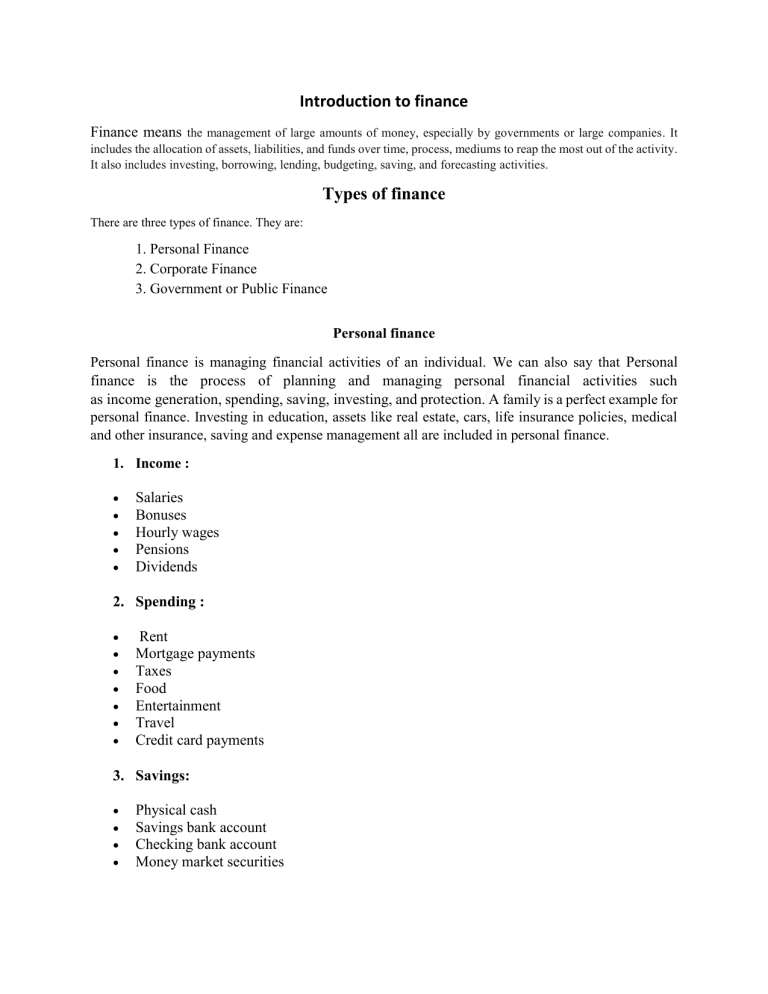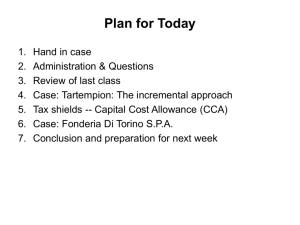
Introduction to finance Finance means the management of large amounts of money, especially by governments or large companies. It includes the allocation of assets, liabilities, and funds over time, process, mediums to reap the most out of the activity. It also includes investing, borrowing, lending, budgeting, saving, and forecasting activities. Types of finance There are three types of finance. They are: 1. Personal Finance 2. Corporate Finance 3. Government or Public Finance Personal finance Personal finance is managing financial activities of an individual. We can also say that Personal finance is the process of planning and managing personal financial activities such as income generation, spending, saving, investing, and protection. A family is a perfect example for personal finance. Investing in education, assets like real estate, cars, life insurance policies, medical and other insurance, saving and expense management all are included in personal finance. 1. Income : Salaries Bonuses Hourly wages Pensions Dividends 2. Spending : Rent Mortgage payments Taxes Food Entertainment Travel Credit card payments 3. Savings: Physical cash Savings bank account Checking bank account Money market securities 4. investing: Stocks Bonds Mutual funds Real estate Private companies Commodities Art 5. Protection: Life insurance Health insurance Estate planning Corporate finance 1. Investments & Capital Budgeting Investing and capital budgeting includes planning where to place the company’s long-term capital assets in order to generate the highest risk-adjusted returns. This mainly consists of deciding whether or not to pursue an investment opportunity. By using financial accounting tools, a company identifies capital expenditures, estimates cash flows from proposed capital projects, compares planned investments with projected income, and decides which projects to include in the capital budget. Using this capital budgeting we can estimate the economic impact of an investment opportunity and compare alternative projects. 2. Capital Financing This core activity includes decisions on how to optimally finance the capital investments (discussed above) through the business’ equity, debt, or a mix of both. Long-term funding for major capital expenditures or investments may be obtained from selling company stocks or issuing debt securities in the market through investment banks. Balancing the two sources of funding (equity and debt) should be closely managed because having too much debt may increase the risk of default in repayment, while depending too heavily on equity may dilute earnings and value for original investors. Ultimately, it’s the job of corporate finance professionals to optimize the company’s capital structure by lowering its Weighted Average Cost of Capital (WACC) as much as possible. 3. Dividends and Return of Capital This activity requires corporate managers to decide whether to retain a business’s excess earnings for future investments and operational requirements or to distribute the earnings to shareholders in the form of dividends or share buybacks. Retained earnings that are not distributed back to shareholders may be used to fund a business’ expansion. This can often be the best source of funds, as it does not incur additional debts nor dilute the value of equity by issuing more shares. At the end of the day, if corporate managers believe they can earn a rate of return on a capital investment that’s greater than the company’s cost of capital, they should pursue it. Otherwise, they should return excess capital to shareholders via dividends or share buybacks.


